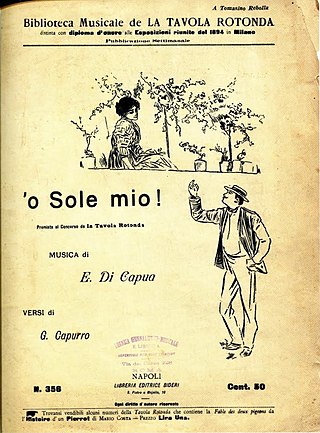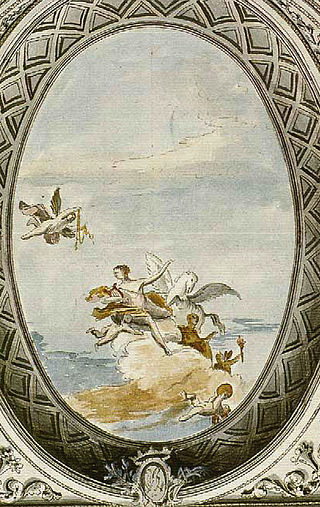You can help expand this article with text translated from the corresponding article in Italian. (October 2013)Click [show] for important translation instructions.
|

Emanuele Barbella (1718-1777) was a Neapolitan composer and violinist. [1]
You can help expand this article with text translated from the corresponding article in Italian. (October 2013)Click [show] for important translation instructions.
|

Emanuele Barbella (1718-1777) was a Neapolitan composer and violinist. [1]

Leonardo Leo, more correctly Leonardo Ortensio Salvatore de Leo, was a Baroque composer.

Tommaso Michele Francesco Saverio Traetta was an Italian composer of the Neapolitan School. Along with other composers mainly in the Holy Roman Empire and France, he was responsible for certain operatic reforms including reducing the ornateness of style and the primacy of star singers.
Eduardo di Capua was a Neapolitan composer, singer and songwriter.

"'O sole mio" is a well-known Neapolitan song written in 1898. Its Neapolitan language lyrics were written by Giovanni Capurro and the music was composed by Eduardo di Capua (1865–1917) and Alfredo Mazzucchi (1878–1972). The title translates literally as "my sun" or "my sunshine". The lyrics have been translated to other languages.
The year 1718 in music involved some significant events.
Giovanni de Macque was a Netherlandish composer of the late Renaissance and early Baroque, who spent almost his entire life in Italy. He was one of the most famous Neapolitan composers of the late 16th century; some of his experimentation with chromaticism was likely influenced by Carlo Gesualdo, who was an associate of his.
Canzone napoletana, sometimes referred to as Neapolitan song, is a generic term for a traditional form of music sung in the Neapolitan language, ordinarily for the male voice singing solo, although well represented by female soloists as well, and expressed in familiar genres such as the love song and serenade. Many of the songs are about the nostalgic longing for Naples as it once was. The genre consists of a large body of composed popular music—such songs as "'O sole mio"; "Torna a Surriento"; "Funiculì, Funiculà"; "Santa Lucia" and others.
Aus Italien, Op. 16, is a tone poem or program symphony for orchestra by Richard Strauss, described by the composer as a "symphonic fantasy". It was completed in 1886 when he was 22 years old. It was inspired by the composer's visit to Italy in the summer of the same year, where he travelled to Rome, Bologna, Naples, Sorrento, Salerno, and Capri. He began to sketch the work while still on the journey.
Emanuele Nutile (1862–1932) was an Italian writer and composer of Neapolitan songs. Nutile, who was born and died in Naples, is remembered especially for "Mamma mia, che vo' sapè", a standard in the Neapolitan repertory that has been recorded by virtually every tenor since Enrico Caruso.

Giuseppe Scarlatti was a composer of opere serie and opere buffe. He worked in Rome from 1739 to 1741, and from 1752 to 1754 in Florence, Pisa, Lucca and Turin. From 1752 to 1754, and again from 1756 to 1759, he worked in Venice and for short periods in Milan and Barcelona. In 1760 he moved to Vienna, where he enjoyed the friendship of Christoph Willibald Gluck. "The third most important musician of his clan", it is still uncertain whether he was born on 18 June 1723 as the nephew of Alessandro or in 1718 as nephew of Domenico. Giuseppe Scarlatti was married to the Viennese singer Barbara Stabili who died about 1753. By 1767 he had married Antonia Lefebvre, who that year bore him a son; she died three years later. Scarlatti died intestate in 1777 in Vienna.

The Teatro San Moisè was a theatre and opera house in Venice, active from 1620 to 1818. It was in a prominent location near the Palazzo Giustinian and the church of San Moisè at the entrance to the Grand Canal.

Stanislao Lista was an Italian sculptor active in Naples.
Cristofaro or Cristoforo Caresana was an Italian Baroque composer, organist and tenor. He was an early representative of the Neapolitan operatic school.
NicolaFiorenza was a Neapolitan violinist and composer of the late Baroque period and a representative of the Neapolitan School.

In music history, the Neapolitan School is a group, associated with opera, of 17th and 18th-century composers who studied or worked in Naples, Italy, the best known of whom is Alessandro Scarlatti, with whom "modern opera begins". Francesco Provenzale is generally considered the school's founder. Others significant composers of this school are Giambattista Pergolesi, Domenico Cimarosa and Giovanni Paisiello.
It is with the Neapolitan school...that the History of Modern Music commences—insofar as that music speaks the language of the feelings, emotions, and passions.
Simon Le Duc, more commonly Leduc, was a French violinist, soloist at the Concert Spirituel, music publisher and composer. His younger brother, Pierre Le Duc (1755–1818), was also a violinist. Leduc was a pupil of the famous violinist and professor at the Paris Conservatoire, Pierre Gaviniès. He later became director of the Concerts Spirituel, with Gaviniès and François-Joseph Gossec
Ensemble Musica Ficta was an Italian early-music ensemble active in the late 1980s and early 1990s. The group consisted of Bruno Ré, Paolo Capirci, Fabio Menditto, Federico Marincola, Andrea Damiani, with tenor Marco Beasley.
Barbella is an Italian surname. Notable people with the surname include:
Pasquale Bini was an Italian violinist and composer.